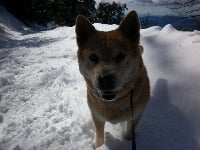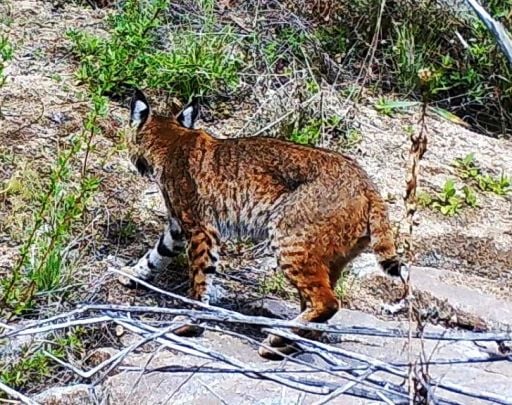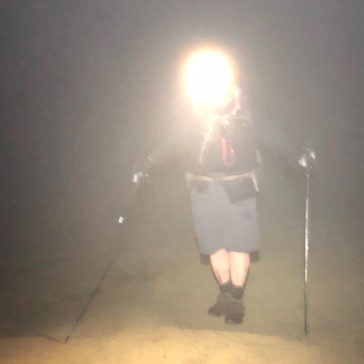Western boundary of the SGM range?
-
Sean

- Cucamonga
- Posts: 4263
- Joined: Wed Jul 27, 2011 12:32 pm
Any opinions about the logical western boundary for the Gabes? Does the range stop at the I-5? Does it extend up to the 138/5 junction?
-
fortified
- Posts: 105
- Joined: Sat Mar 02, 2013 10:03 pm
Sean,
If I may change the subject for a minute. I don't remember, but you might be one of the people that helped explain the Lone tree trail when I first climbed it about two years ago.
I see your link with the red points and pictures on that rail.
The first time I went, I didn't realize that some sort of use trial was near the top.
The area between your last picture, and final larger red point, (it doesn't have a picture) is where I might have gone off.
If I remember correctly, I actually went to the left of your markings.
I have never been a rock climber, and was a bit uneasy. Have you ever been to that point where you are sure its going to get easier with just a couple more steps....and so on......then you are past the point of no return.
Yeah, I am a lightweight. .....But, the Sun had just set, and I was hiking by myself, at 56 years old, with six ounces of water. I could have done more wrong but decided that was enough for one occasion.
I haven't hiked it since then. Are you familiar with the condition these days?
Compared to a couple years ago.......?
Also, that reconnection of the ridge on top of Lake Ave that connects on the left to the Mt. Lowe road is my favorite one these days.
My all time record for going from the top of lake to Echo via the ridge, Mt Lowe road and the Mt. Lowe railway trail to Echo is 43 minutes.
Thanks
If I may change the subject for a minute. I don't remember, but you might be one of the people that helped explain the Lone tree trail when I first climbed it about two years ago.
I see your link with the red points and pictures on that rail.
The first time I went, I didn't realize that some sort of use trial was near the top.
The area between your last picture, and final larger red point, (it doesn't have a picture) is where I might have gone off.
If I remember correctly, I actually went to the left of your markings.
I have never been a rock climber, and was a bit uneasy. Have you ever been to that point where you are sure its going to get easier with just a couple more steps....and so on......then you are past the point of no return.
Yeah, I am a lightweight. .....But, the Sun had just set, and I was hiking by myself, at 56 years old, with six ounces of water. I could have done more wrong but decided that was enough for one occasion.
I haven't hiked it since then. Are you familiar with the condition these days?
Compared to a couple years ago.......?
Also, that reconnection of the ridge on top of Lake Ave that connects on the left to the Mt. Lowe road is my favorite one these days.
My all time record for going from the top of lake to Echo via the ridge, Mt Lowe road and the Mt. Lowe railway trail to Echo is 43 minutes.
Thanks
-
walker

- Posts: 248
- Joined: Mon Apr 08, 2013 11:14 pm
That would seem to make sense as the 138 roughly follows the San Andreas zone up to the Gorman area and then the 5 comes south down a canyon system from Tejon Pass and Frazier Park, I guess that's part of Piru Creek and then Castaic Creek, though maybe tracing Piru Creek would be the more prominent natural boundary line? My own experience doesn't extend into that region much beyond the 14 and I only know that it's included in the ANF. Maybe locals from up that way would have a better handle on this.
It looks like the USGS designates the range north of Quail Lake as the west end of the Tehachapis. I've always heard everybody call everything west of the 5 out to Santa Barbara the Los Padres, without really specifying a single grand range name. There really is a staggering amount of mountain terrain around here.
It looks like the USGS designates the range north of Quail Lake as the west end of the Tehachapis. I've always heard everybody call everything west of the 5 out to Santa Barbara the Los Padres, without really specifying a single grand range name. There really is a staggering amount of mountain terrain around here.
-
Sean

- Cucamonga
- Posts: 4263
- Joined: Wed Jul 27, 2011 12:32 pm
If you're talking about the route above the West Fuji plateau, after you pass through the oak trees, then that section receives no maintenance at all, but the use Trail is well established and has a few cairns here and there. It's mostly an old firebreak straight up the Ridge, then three old bulldozed switchbacks which are now covered in rocks, then remnants of the old Trail the remaining distance to Panorama Point. Some have been shortcutting the switchbacks and have established a pretty clear use path between them. I'm not sure where you hit the rock climbing, but the main route between Fuji and Panorama is fairly straightforward class 1, maybe easy 2.fortified wrote: Are you familiar with the condition these days? Compared to a couple years ago.......?
-
Sean

- Cucamonga
- Posts: 4263
- Joined: Wed Jul 27, 2011 12:32 pm
Yeah, it would be nice to know what is going on with the Los Padres NF group of mountains. Does that range have a name? I've only done a handful of hikes out there, but it's like I'm hiking in the Twilight Zone each time.walker wrote: I've always heard everybody call everything west of the 5 out to Santa Barbara the Los Padres, without really specifying a single grand range name.
-
tekewin

- Posts: 1389
- Joined: Thu Apr 11, 2013 5:07 pm
I think the San Gabriels end at the 14, while the Angeles National Forest continues north with everything south of the 138, but also includes some of the mountains west of I-5.
For example, Frenchmans Flat Campground is considered part of ANF, west of the I-5 by Pyramid Lake. If you look at the USGS map in Caltopo, you can see the boundary between the ANF and Los Padres is just west of there and runs down through Lake Piru and follows Piru Creek. Very murky unless you spend a lot of time around there.
For example, Frenchmans Flat Campground is considered part of ANF, west of the I-5 by Pyramid Lake. If you look at the USGS map in Caltopo, you can see the boundary between the ANF and Los Padres is just west of there and runs down through Lake Piru and follows Piru Creek. Very murky unless you spend a lot of time around there.
-
mattmaxon

- Posts: 1137
- Joined: Mon Mar 24, 2008 12:48 pm
The area generally north of Santa Clarita, west of Liebre Mtns is the Ridge Basin. Sierra Palona Mtns are the north / south ranges from the AV to Santa Clarita
-
AW~

- Posts: 2096
- Joined: Mon Oct 01, 2007 12:00 pm
From a little reading, the mountains stop on the western boundary, but the rocks cover into other mountain ranges....so does that mean the San Gabriels successfully got more territory? Im reading anorthosite and Medenhall gneiss would take it further west....but maybe another range also snuck on top of the San Gabriels, so did the San Gabriels lose territory back in the day?
There is a link to a LA county geologist with even another interpretation, going way west, even beyond the takeover boundaries.
http://egis3.lacounty.gov/eGIS/2011/12/ ... g-in-size/
There is also a link to the USGS map...From that map, I guess they use the old territory(Vincent thrust), so that would be the 14 freeway, but then they added a territory just west of that into Santa Clarita to support a growing SG mountains so....
There is a link to a LA county geologist with even another interpretation, going way west, even beyond the takeover boundaries.
http://egis3.lacounty.gov/eGIS/2011/12/ ... g-in-size/
There is also a link to the USGS map...From that map, I guess they use the old territory(Vincent thrust), so that would be the 14 freeway, but then they added a territory just west of that into Santa Clarita to support a growing SG mountains so....
-
Sean

- Cucamonga
- Posts: 4263
- Joined: Wed Jul 27, 2011 12:32 pm
I found out something about the mountain range West of the Tejon Pass. It's called San Emigdio and contains Mt. Pinos. Has anyone ever seen signage for this range in that area?
-
Uncle Rico

- Posts: 1481
- Joined: Thu Mar 20, 2008 7:48 pm
I have never seen signage referencing the San Emigdio Mountains, but I also haven't spent any time on the north side of the Cuddy Valley. In other words, I'm no help at all.
-
Sean

- Cucamonga
- Posts: 4263
- Joined: Wed Jul 27, 2011 12:32 pm
That's okay. It's always nice to hear from you--if only to be reminded that you're still alive and able to communicate.Uncle Rico wrote: In other words, I'm no help at all.
-
David R
- OG of the SG
- Posts: 632
- Joined: Sun Jun 12, 2011 10:28 pm
Yes I would say that the 14 and I-5 ring in the San Gabes which is different from the Angeles National Forest which continues north of the 14 until the 138 which is the Sierra Pelona range. The other areas do not have a uniform mountain range which makes it more complicated. Heading west you have numerous ranges, here is an excerpt from Ventura County geography that is a nice summary.
The Western Transverse Ranges are the dominant landform of Ventura County, occupying the northern two-thirds of the land area of the county. The Western Transverse Ranges are a collection of east-west trending mountain ranges with intervening valleys. As the name implies, the Transverse Ranges trend transversely to that of the other mountain ranges in California, which trend along north-south axes. The Western Transverse Ranges are extremely rugged and have high relief, ranging from sea level west of Ventura along the Rincon coast to 2,682 m (8,831 ft.) on Mount Piños at the very northern edge of Ventura County.
The primarily mountain ranges within Ventura County that make up the western Transverse Ranges, from south to north (and west to east) are:
• Rincon Mountain/Ventura Hills/Santa Paula Mountain;
• Santa Ynez Mountains/Nordhoff Ridge/Topatopa Mountains/Hopper Mountain/Whiteacre Peak;
• Ortega Hill/Dry Lakes Ridge;
• Pine Mountain Ridge/Sewart-Alamo Mountains/Cobblestone Peak;
• Mount Abel-Sawmill Mountain-Mount Piños/Frazier Mountain; and
• Conejo/Santa Monica Mountains (here separated out with the Santa Susana Mountains and Simi Hills as a distinct phyiographic region).
The San Emigdio Range occurs immediately north of Mount Piños and Frazier Mountain, divided by the San Andreas Fault, which for the most part occurs in Kern County. Only the northeastern corner of Ventura County contains a small portion of the San Andreas Fault, placing all of Ventura County on the Pacific Plate. Intervening valleys, from south to north, include: Cañada Larga, Ojai Valley, Matilija Canyon, middle Sespe Creek (including Rose Valley), upper Sespe Creek, Cuyama Badlands (including Ozena Valley, Dry Canyon, Apache Canyon, Quatal Canyon, and smaller canyons), and Lockwood Valley. Cuddy Valley occupies the San Andreas Fault Zone immediately north of Mount Piños and Frazier Mountain in Kern County.
The Western Transverse Ranges are the dominant landform of Ventura County, occupying the northern two-thirds of the land area of the county. The Western Transverse Ranges are a collection of east-west trending mountain ranges with intervening valleys. As the name implies, the Transverse Ranges trend transversely to that of the other mountain ranges in California, which trend along north-south axes. The Western Transverse Ranges are extremely rugged and have high relief, ranging from sea level west of Ventura along the Rincon coast to 2,682 m (8,831 ft.) on Mount Piños at the very northern edge of Ventura County.
The primarily mountain ranges within Ventura County that make up the western Transverse Ranges, from south to north (and west to east) are:
• Rincon Mountain/Ventura Hills/Santa Paula Mountain;
• Santa Ynez Mountains/Nordhoff Ridge/Topatopa Mountains/Hopper Mountain/Whiteacre Peak;
• Ortega Hill/Dry Lakes Ridge;
• Pine Mountain Ridge/Sewart-Alamo Mountains/Cobblestone Peak;
• Mount Abel-Sawmill Mountain-Mount Piños/Frazier Mountain; and
• Conejo/Santa Monica Mountains (here separated out with the Santa Susana Mountains and Simi Hills as a distinct phyiographic region).
The San Emigdio Range occurs immediately north of Mount Piños and Frazier Mountain, divided by the San Andreas Fault, which for the most part occurs in Kern County. Only the northeastern corner of Ventura County contains a small portion of the San Andreas Fault, placing all of Ventura County on the Pacific Plate. Intervening valleys, from south to north, include: Cañada Larga, Ojai Valley, Matilija Canyon, middle Sespe Creek (including Rose Valley), upper Sespe Creek, Cuyama Badlands (including Ozena Valley, Dry Canyon, Apache Canyon, Quatal Canyon, and smaller canyons), and Lockwood Valley. Cuddy Valley occupies the San Andreas Fault Zone immediately north of Mount Piños and Frazier Mountain in Kern County.
